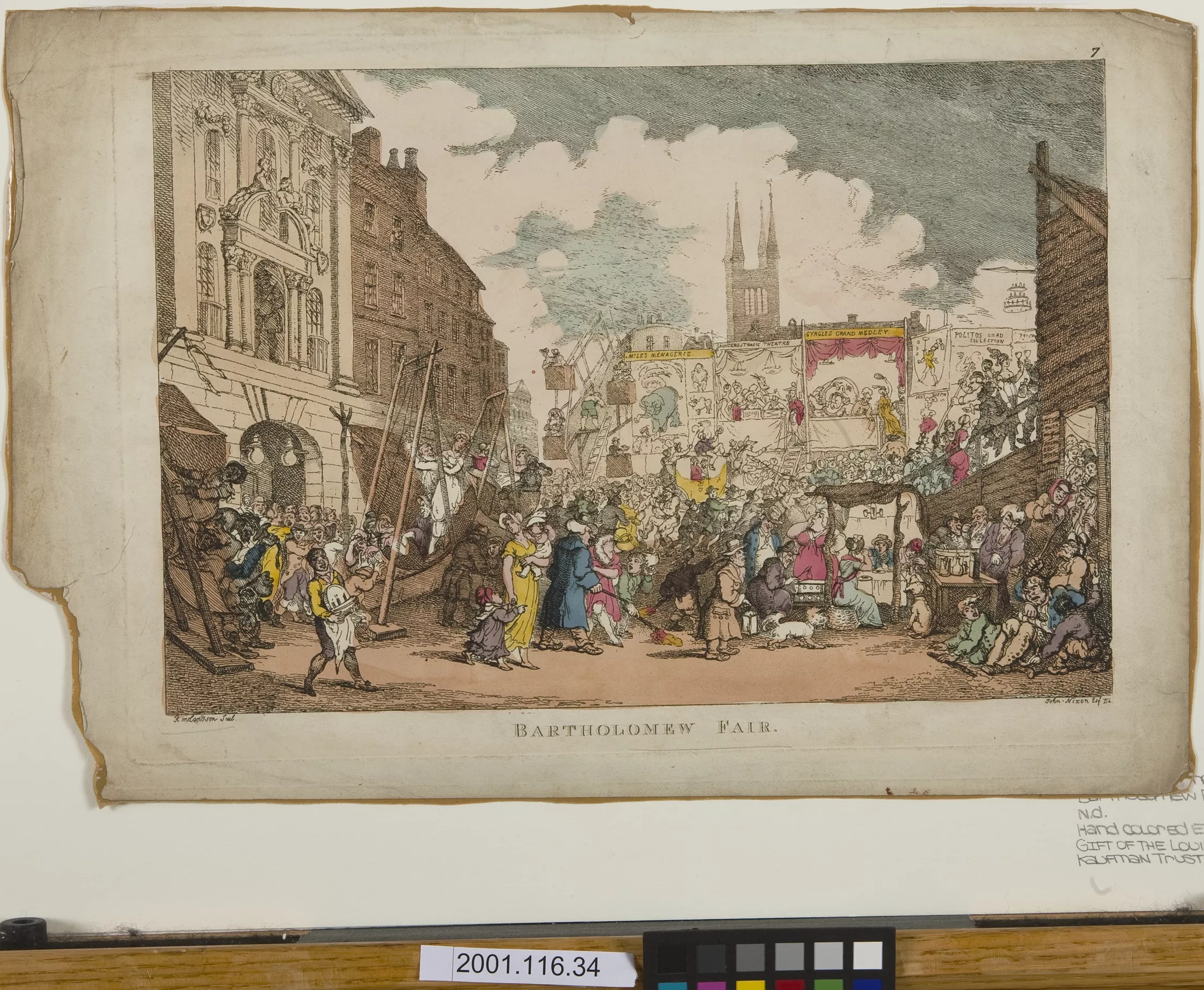Creation Date
1808
Medium
Genre
Description
St. Bartholomew’s Fair was one of the highlights of the London social season, drawing crowds from all strati of society.
With church spires rising above it in the very center of the background, Bartholmew Fair is in full swing, crowded with people and chaos. Overflowing the square—with the hospital on one side, a wooden structure on the left, and show booths in the background—is a diverse crowd of men and women, adults and children, infants and dogs, from all social classes and races. On the right are a row of boat swings, the nearest one overturning. At the end of the line of boat swings is a precursor to the Ferris wheel. Along the back are the booths of Miles’ Menagerie, Suander’s Tragic Theatre, Gingle’s Grand Medley, Miss Biffin, Polito’s Grand Collection, and Punch. Inebriated customers surround the drinking stalls on the left; one man has passed out and is being robbed. In the midst of the crowd sailors arrive in a coach, and a ring is formed for fair fighting (Gregor 2: 93).
In 1102, the Priory, Hospital, and Church of St. Bartholomew were founded in West Smithfield, just beyond the London city walls. They were founded by Rayer (also known as Rahere from his Latin name, Raherus), the court jester of Henry I, who held an occasional King’s Market (Morley 1). The monastery was dissolved in 1528. Through the centuries, it has also variously been the site of markets, jousting tournaments, public executions, the burning place of heretics, and burial grounds for plague victims (Thomson 76). The site’s most famous event was the Bartholomew Fair: beginning in 1133 as a pilgrimage and festival, by 1855 it had developed into a major, two-week fair of trading and entertainment that commenced annually on August 24th. The fair attracted crowds from all levels of English society: “It more or less illustrated the social history of the metropolis, and in some sort its trading practices” (Walford 164). Drawing tens of thousands of people, Bartholomew Fair became known as the “biggest and longest-lived of the London fairs,” rivaling even the May-Fair (Atlick 35). The fair also continued to host theatrical spectacles after London theaters were forced to close (Thomson 77). Bartholomew Fair was shut down too, however, in the mid-nineteenth century, after being condemned by authorities as a cause of public disorder and debauchery.
Though originating as a gathering of religious purpose, Bartholomew Fair became a commercial event centered around trade and popular entertainment. As one of the highlights of the London social season, it drew crowds from across society. This extreme mixing of classes, however, and particularly the bringing together of the lower classes, came to be seen as a threat to social order and common morality; tens of thousands went to the fair to eat, drink, gamble, and brawl (Atlick 35). Given the alleged unhealthiness of its atmosphere, the fair was shut down in the nineteenth century. Images like Bartholomew Fair illustrate and confirm the social chaos feared by the authorities: “Judging from the caricature, the abolition of fairs in the City must have been a boon to public order and morality” (Gregor 2: 92). In Rowlandson’s depiction of the fair, the drinking stalls overflow with inebriated people, this social and moral evil leading to another as one unconscious drunk is consequently robbed. This moral domino effect or chain of immorality encapsulates the fear of the fair as a breeding ground of destructive excess and disintegration. Even the amusements are tinged with impropriety: women and men dance with glasses and a bottle in hand, and the boat swings set their riders tumbling out. Moreover, at the center of the chaos is a mother, her children in tow, a familial sight that is rendered questionable by the fact that she is unaccompanied. Rowlandson thus implicitly gives warning of the dangers of the fair to the family.
As a site of extreme social mixing and moral chaos, Bartholomew Fair initiated fairgoers into improper modes of viewing and interaction. The "sights to see" are neither artistic works of drama nor the fashionable display of people at the theater, but rather the chaos of rowdy revelers and illicit or juvenile amusements; the "theater" at the fair was comprised of stalls offering popular shows such as Punch. There were also booths that exhibited curiosities, humans or animals that were considered "monsters" or "freaks" (Atlick 36). Thus, the spectacles offered at the fair were intended to shock and amuse rather than edify their audience. Rowlandson depicts this sense of shocked spectatorship not by providing the viewer with such sights, but by offering a scene that hints at the illicit activities and sights the depicted fairgoers are likely, in this site of disorder and tumult, to see. Through this portrayal then, the fair is experienced by the viewer as a chaotic mix of popular entertainment that is both tasteless and morally reprehensible.
Publisher
Rudolph Ackermann
Accession Number
2001.116.34
Additional Information
Bibliography
Altick, Richard Daniel. The Shows of London. Boston: Harvard UP, 1978. Print.
Gregor, Joseph. Rowlandson the Caricaturist: A Selection from His Words, with Anecdotal Descriptions of his Famous Caricatures and a Sketch of his Life, Times, and Contemporaries. 2 vols. London: Chatto and Windus, 1880. Print.
Hallett, Mark, and Christine Riding, eds. Hogarth. London: Tate, 2006. Print.
Morley, Henry. Memoirs of Bartholomew Fair. 4th Ed. London: Routledge, 1892. Print.
Pyne, W.H. and William Combe. The Microcosm of London; or, London in Miniature. 3 vols. London: Ackermann, 1904. Print.
Thomson, Rosemarie Garland. Freakery: Cultural Spectacles of the Extraordinary Body. New York: New York UP, 1996. Print.
Walford, Cornelius. Fairs, Past and Present: A Chapter in the History of Commerce. London, 1883. Print.

